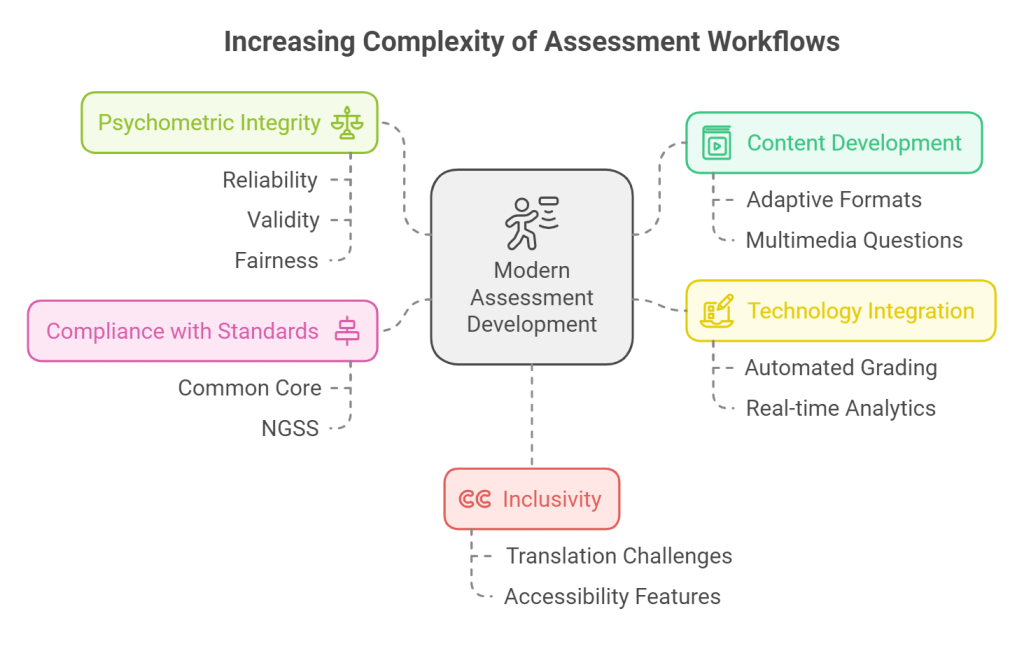The Backbone of Modern Assessment Development: Strategic Program Management

In today’s dynamic educational landscape, assessment development has transitioned from a linear, content-focused process to a sophisticated, multi-dimensional endeavour. Driven by the adoption of digital-first strategies and frequent updates to educational standards, publishers are no longer tasked solely with creating pedagogically sound content. They must now ensure their assessments are technologically robust, accessible to diverse learners and rigorously aligned with evolving benchmarks.
As these demands grow, strategic program management has emerged as a critical enabler, transforming fragmented workflows into cohesive systems. Far from a supportive function, program management now serves as the backbone of assessment initiatives, empowering organizations to navigate complexity with precision and deliver impactful solutions.
The Increasing Complexity of Assessment Workflows
Modern assessment projects operate at the intersection of education, technology and policy. Unlike traditional workflows, today’s initiatives require the seamless integration of diverse elements to ensure quality, relevance and accessibility for a wide range of learners. Each stage must address specific challenges while contributing to the overall success of the project. Below are the most critical components of contemporary workflows:
1. Content Development Tailored to Subjects and Grade Levels
Assessments today must accommodate diverse subjects, grade levels and learning objectives. Test items are tailored to meet the developmental needs of specific age groups, ranging from simple visuals for young learners to intricate, multi-step scenarios for high school students. Publishers increasingly rely on adaptive, multimedia, and open-ended question formats to support personalized and differentiated learning.
2. Ensuring Psychometric Integrity: Reliability, Validity and Fairness
Psychometric principles are essential for creating assessments that are accurate and equitable. Reliability ensures consistent results, while validity guarantees that assessments measure intended outcomes. Addressing fairness eliminates cultural or contextual biases that may disadvantage specific groups, ensuring inclusivity—particularly in high-stakes testing, where outcomes have significant impacts on students.
3. Seamlessly Integrating Technology Platforms for Digital-First Assessments
The rise of digital-first and hybrid learning models has made robust technology platforms a cornerstone of assessment delivery. These platforms enable automated grading, real-time analytics and interactive question types. Compatibility across devices and secure data protocols are essential for equitable access, while user-friendly designs enhance the experience for both educators and learners.
4. Maintaining Compliance with Educational Standards and Benchmarks
Educational standards like Common Core, NGSS, or state-specific benchmarks serve as a blueprint for ensuring assessments align with required learning objectives. However, alignment is resource-intensive, requiring frequent updates to match evolving policies. Agile workflows are essential to maintaining compliance and ensuring assessments remain credible and relevant in diverse educational settings.
5. Prioritizing Multilingual Access and Universal Design
Inclusive assessments prioritize multilingual access and universal design. Translating test items without altering meaning or difficulty is a key challenge, as is incorporating accessibility features such as screen readers, alternate text formats and simplified layouts. These considerations ensure compliance with WCAG and ADA standards, making assessments accessible to all learners, including those with disabilities.

Managing these interconnected components in a single large-scale initiative demands strategic foresight, adaptability and precision. Fragmented workflows, miscommunication, or inconsistent quality can easily derail progress, leading to delays and missed opportunities.
Strategic program management addresses these complexities by establishing a cohesive framework that anticipates challenges, aligns cross-functional teams, and upholds standards of excellence across all phases of assessment development.
Key Principles for Effective Project Oversight in Educational Publishing
As assessment workflows grow more complex, maintaining clarity, alignment, and agility across all stages of development becomes critical. Strategic program management provides a structured approach to navigating these complexities, ensuring that diverse teams and processes work in harmony. Several foundational principles underlie effective project oversight, enabling publishers to manage multifaceted initiatives with precision and efficiency.
1. Comprehensive Visibility and Transparency
Real-time access to project data is indispensable for proactive decision-making. By implementing dynamic dashboards, project managers can track progress across multiple streams, monitor resource allocation and identify bottlenecks before they escalate. This visibility enables organizations to pivot swiftly, ensuring that each project milestone remains on schedule.
2. Integrated Communication Protocols
With cross-functional teams often spread across departments or geographies, miscommunication is a significant risk. Establishing structured communication frameworks ensures alignment, whether through shared collaboration platforms, standardized reporting templates, or clearly defined meeting cadences. This ensures that stakeholders—from content creators to IT specialists—remain synchronized with project objectives.
3. Adaptive Resource Allocation
Projects of this scale demand flexibility. Adaptive resource allocation enables organizations to respond dynamically to shifting priorities—whether reallocating psychometricians to validate new question types or increasing technical capacity to resolve platform issues. This principle ensures that resources are optimally utilized throughout the project lifecycle.
Risk Management Strategies for Large-Scale Initiatives
In large-scale assessment initiatives, risks—whether technical, operational, or compliance-related—can disrupt even the best-laid plans. A well-structured risk management strategy ensures that potential vulnerabilities are identified and addressed before they impact project outcomes, keeping timelines and quality intact.
1. Comprehensive Preliminary Risk Assessments
Thorough risk assessments at the start of a project help map potential vulnerabilities across content, technology and operations. For example, dependencies between content creation and platform integration can lead to delays if not accounted for early. Proactively identifying these risks enables teams to implement solutions before they escalate.
2. Contingency Planning
Strategic contingency plans minimize disruptions by providing fallback options. These plans might include maintaining backup content pipelines, preparing alternative technical solutions, or creating secondary validation workflows to ensure uninterrupted progress when primary approaches encounter hurdles.
3. Continuous Quality Assurance (QA)
Multi-stage QA checkpoints embedded throughout the project lifecycle are essential for detecting and resolving issues early. This includes validating alignment with educational standards, verifying accessibility compliance, and ensuring compatibility across devices and platforms. Continuous QA reduces the risk of last-minute setbacks and guarantees that each component meets rigorous quality standards.
The Strategic Partnership Advantage
While internal program management capabilities remain essential, publishers increasingly benefit from collaborating with specialized assessment development partners. These partnerships offer a distinct strategic advantage by addressing resource constraints and enhancing operational efficiencies. Key benefits include:
- Proven Methodological Frameworks: External partners bring established workflows for managing complex, multi-stream projects.
- Cross-Industry Expertise: With insights from various educational and technological domains, they provide innovative solutions to unique challenges.
- Scalable Infrastructures: Reliable access to on-demand resources allows organizations to handle fluctuating workloads during peak project phases.
- Experience Navigating Complexities: Specialized teams excel in managing alignment with regional standards or resolving integration issues for cutting-edge technologies.
By leveraging partnerships, publishers can access niche expertise and proven frameworks that might take years to develop in-house, enabling sharper focus on delivering high-quality educational content.
The Strategic Imperative: Precision-Oriented Program Management for Assessment Success
As the demands on educational assessment continue to expand, strategic program management has evolved from a best practice to an operational necessity. Organizations that adopt comprehensive, adaptable, and technologically informed management approaches are better positioned to deliver high-quality, standards-aligned assessments that meet the needs of educators and learners alike.
The future of assessment development lies in precision orchestration: the ability to harmonize expertise, advanced technologies, and seamless workflows to produce timely and reliable results. Strategic program management anchors this vision, ensuring every component operates cohesively to achieve impactful educational outcomes.
Recent Blogs

AI-Supported Pedagogy Has Arrived. Now Comes the Content Reckoning.



